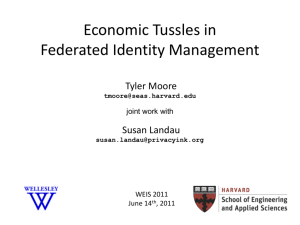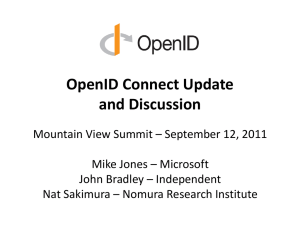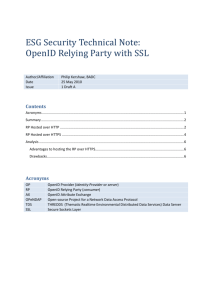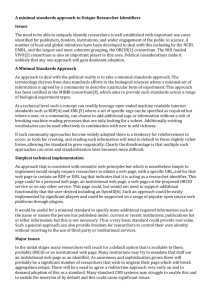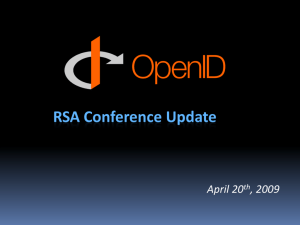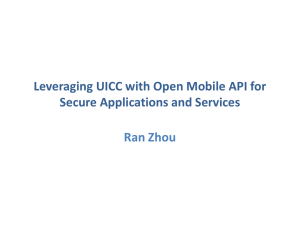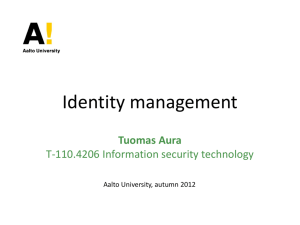The Design and Implementation of an OpenID
advertisement
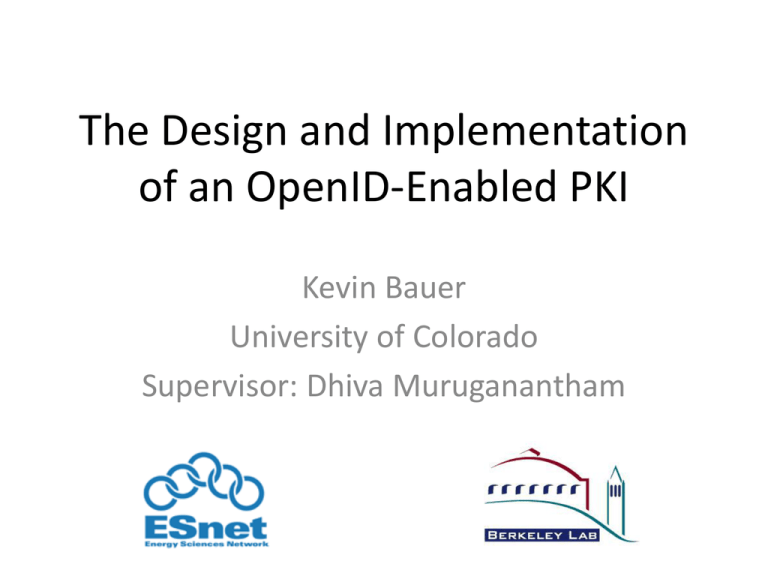
The Design and Implementation of an OpenID-Enabled PKI Kevin Bauer University of Colorado Supervisor: Dhiva Muruganantham The Login Explosion Problem • Everyone uses a variety of web services – E-mail, social networking sites, blogging sites, online collaboration tools, etc. • But each site has a unique way for us to login • Wouldn’t it be great to have just one set of credentials? 1 Solution: OpenID For example: http://ksbauer.myopenid.com 2 What is OpenID? • OpenID is an authentication protocol – It provides a way for a user to prove their identity • OpenID’s primary design considerations: – Simplify your online experience • Eliminates the need for multiple user names and passwords • Single Sign-On: Authenticate once, log-in many times – Decentralized • No central authorities, users are free to choose their identity providers – Third-party websites never see authentication credentials • Your user names and passwords are safer – Built on existing web technologies • Leverages the ubiquity of HTTP(S), URI, XML, SSL, Diffie-Hellman • No specialized technologies are necessary 3 How Does OpenID Work? 1. RP asks the user to login Relying party provides an interface to request user’s OpenID URI 2. User submits OpenID URL 3. Perform URL discovery RP 4. Return IdP endpoint 5. Request login 8. Return auth. result http://natron.es.net/openid/kevinbauer3 User IdP 6. Redirect user to IdP 7. User logs in 9. Grant user access? Website (relying party or RP) Identity Provider (IdP) End User 4 OpenID IdP Discovery • Which identity provider is responsible for authenticating this user? HTTP HEAD: http://natron.es.net/openid/kevinbauer3 Retrieve HTTP response headers 200 OK Date: Tue, 11 Aug 2009 17:55:47 GMT Server: Apache/2.2.11 (Fedora) DAV/2 mod_ssl/2.2.11 Content-Type: text/plain … Client-Date: Tue, 11 Aug 2009 17:55:47 GMT Client-Peer: 198.128.5.22:443 Client-Response-Num: 1 X-XRDS-Location: https://natron.es.net/claimed_xrds.jsp? opEndpoint=https://natron.es.net/provider Identity provider endpoint URL is discovered 5 OpenID User Authentication • Redirect user to the discovered IdP endpoint • IdP authenticates the user User should manually verify IdP URL when authenticating with a password (to mitigate phishing attacks) The referring site is displayed The user provides their authentication credentials to the IdP 6 OpenID User Authentication (2) • User approves the authentication request The user explicitly authorizes the release of the authentication result • Authentication result is shared with the relying party 7 OpenID and User Information • Beyond authentication, OpenID provides a structured way of sharing information about you • Simple Registration Protocol – Lightweight profile exchange • Full name, nickname, e-mail, date of birth, gender, postcode, country, language, and time zone • Attribute Exchange Protocol – More flexible information exchange – Allows RP to request any information about users 8 Our Project: Develop OpenID Infrastructure for ESnet Three main deliverables for our project: 1. OpenID identity provider 2. OpenID-enabled certificate authority 3. OpenID-enabled collaboration tool (TWiki) 9 ESnet OpenID Provider Two authentication methods: username/passwords, client certificates Persistent Account Storage: - LDAP to store authentication credentials - MySQL database to store user attributes Registration Validation: Send confirmation e-mail to verify the account creation (for password-based accounts) Automatic Registration: Automatic enrollment for token holders; All “international grid trust federation” certs. trusted 10 Demo: OpenID Identity Provider 11 OpenID-Enabled Certificate Authority • Goal: Enable users to request short-term certificates using their OpenID automatically A relying party User enters their OpenID IdP whitelisting Or logs-in directly with their IdP 12 Demo: Certificate Request with OpenID 13 OpenID Collaboration Site • Goal: Use OpenID to login to an ESnet TWiki • TWiki is an example of another OpenID relying party OpenID authentication http://natron.es.net/openid/kevinbauer3 • Obtains user information from the attribute exchange 14 Demo: OpenID for Collaboration: Twiki 15 OpenID Summary OpenID offers the following benefits: • Single sign-on simplifies the online experience • Third-parties don’t know our passwords • Trust is decentralized • Easy to deploy, built on proven web technologies But, OpenID is not a perfect solution… 16 Open Problems with OpenID: Phishing • What is phishing? Example: An attempt to steal usernames/passwords by impersonating a legitimate (high value) website • Particularly dangerous because OpenID credentials may grant access to a large number of accounts • Design effective UIs and educate users about risks – Users should verify URLs and SSL certificates before releasing their passwords • Certificate-based authentication largely solves this 17 Open Problems with OpenID: Hard to Leave the Web Browser • Can we use OpenID with non-web applications? – GridFTP, SSH, other legacy applications outside the browser • Simple answer: Not really – OpenID relies on browser interactions between the user and their IdP – Single sign-on functionality needs browser session state • More complicated answer: Maybe – Mimic the browser functionality within the legacy app – Requires the legacy app to be modified (it’s now an RP) 18 Open Problems with OpenID: User’s Privacy May Be at Risk • OpenID exposes user information in two ways – Problem: Attribute exchange releases user’s name, email, etc. to relying parties • Solution: Give user’s ability to control what information is released about them – Problem: OpenID identifiers are persistent and global identifiers Behavior can be linked over time • Solution: Give users dynamic identifiers, a different identity each time they login to an RP 19 One-time Use Identifiers Mitigates Tracking Login to RP with the IdP endpoint, not OpenID https://natron.es.net/provider This allows the user to login directly with their IdP Authenticate with the IdP as normal and ask for onetime use identifier IdP returns a randomly https://natron.es.net/openid/1exrt9ezhp9ug generated and authenticated OpenID to the RP https://natron.es.net/openid/36lse1cyoz4u Login again and get a new random ID 20 Demo: One-time Use Identifiers 21 OpenID/Shibboleth Comparison • Both protocols offer – Cross-domain authN – Attribute exchange – Single sign-on • Key Differences – Trust model • OpenID assumes a completely open trust model • Shibboleth is federated; trust only a limited set of IdPs – Freedom to choose your IdP • OpenID allows users to chose any IdP • Shibboleth requires that authentication be handled by your “home institution” (LBNL, ESnet, UC-Berkeley, etc.) 22 Future Work • Currently finishing a blog site to provide up-todate information about our OpenID service • Explore OpenID + OAuth as a way to enable non-web OpenID authentication • Explore how Shibboleth and OpenID can interoperate • Continue to improve the OpenID provider’s UI 23 Summary and Conclusion • We developed OpenID infrastructure that includes: – An ESnet-operated OpenID identity provider – An automated short-term certificate issuing service that consumes OpenID – A TWiki-based collaboration site that consumes OpenID • Thank you to Dhiva, Mike, and ESnet staff 24
